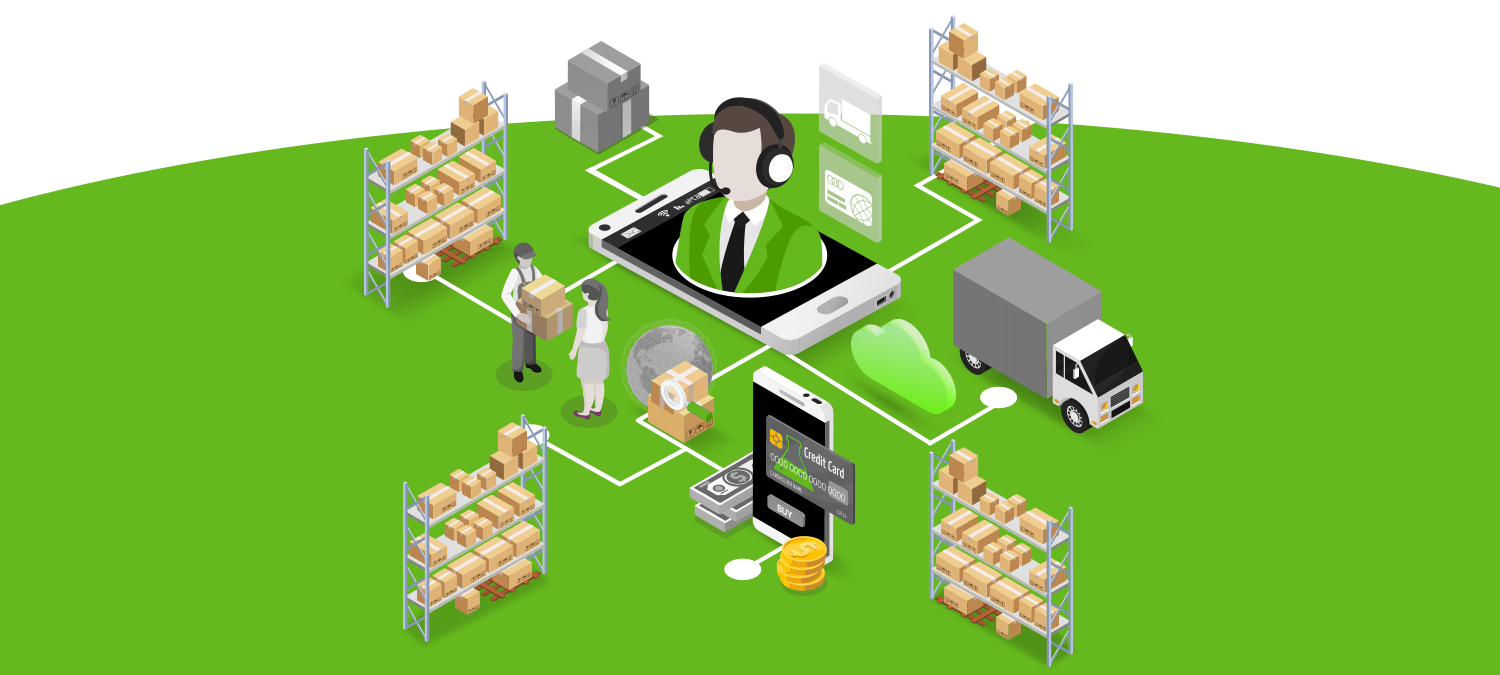For e-commerce companies, scaling the business is often associated with increasing the number of warehouses. Tthe more storage points you have, the more challenging the task of efficient inventory management becomes. Being unprepared for such expansion can be a source of serious difficulties.
You may encounter inventory shortages, delivery delays, and ultimately, customer loss. However, these are just some of the issues faced by companies without a multi-warehouse management system.
In this article, we will explore what multi warehouse management is, its benefits, and the challenges it brings. We will also provide tips for successfully overcoming these challenges.
- What is Multi Warehouse Management?
- Advantages of Multi-Warehouse Management
- Challenges Associated with Multi-Warehouse Management
- Efficient Multi-Warehouse Management: Practical Tips
- Conclusion
- Frequently Asked Questions
What is Multi Warehouse Management?
Multi-warehouse management is a strategic approach to organizing and controlling inventory in multiple locations simultaneously. It is a practice capable of providing a flexible and efficient logistics chain. It is based on coordinating and optimizing all aspects of warehouse operations, including receiving, storage, accounting, shipping, and redistributing goods. Multi-warehouse management is particularly relevant for companies with a broad geographic scope or a complex structure of product supply.
Each warehouse can specialize in storing specific products or serve particular regions to meet the needs of different customers. This strategy also involves the use of technology for centralized inventory management, monitoring, and coordination of logistics operations across multiple warehouses.
Advantages of Multi Warehouse Management
Speed, flexibility, and reliability are key elements of successful order fulfillment. In the quest for effective strategies to achieve these goals, multi-warehouse management stands out as a strategically important direction. Having multiple warehouses allows your company to optimize the logistics chain and provides several other advantages.
Reduction of time and costs for delivery
Distributing inventory across different warehouses allows optimizing logistics processes by reducing the distance between products and the final delivery points. This improves overall operational efficiency and enables faster responsiveness to customer orders.
Since the goods are located closer to their destination, you can reduce transportation costs and minimize the environmental impact. This is particularly important given the modern requirements for business sustainability and environmental friendliness.
Risk mitigation in delivery
Multi-warehouse management provides your company with an additional layer of protection against unforeseen circumstances. Accidents, natural disasters, or supply issues at one of the warehouses won’t bring the entire logistics chain to a halt. You can ensure continued delivery thanks to the presence of alternative and geographically distributed backup warehouses.
Flexibility and precision in inventory management
Multi-warehouse management provides the ability to respond promptly to changes in demand and mitigate risks of excess or insufficient inventory. Additionally, it allows your company to consider the specificity of consumer demand in different regions. You can create personalized and relevant offers for your customers.
Improving customer service level
Customers appreciate the speed and reliability of a brand. By reducing delivery time and costs, you can meet current customer needs and build a foundation for long-term relationships.
Expansion opportunities
Multiple warehouse management not only enhances logistics for current markets but also facilitates easy expansion of service geography. Your company will be able to quickly respond to new opportunities and market demands by opening delivery points in new regions.
Challenges Associated with Multi Warehouse Management
Multi-warehouse management offers numerous benefits for effective inventory management and logistics. However, expanding a warehouse network can pose certain challenges. What are these challenges, and how can they impact the operational activities of the enterprise? Let’s delve into that.
Maintaining an optimal level of inventory across all points
Insufficient stock at one of the warehouses can lead to missed sales opportunities, dissatisfied customers, and potential revenue loss. On the other hand, excess inventory can result in additional costs for storage and the risk of product obsolescence.
Addressing this issue requires integrated inventory management systems and modern technological solutions to optimize logistics processes.
Challenges in synchronizing operations across warehouses
In multi-warehouse management, companies also encounter challenges in synchronizing operations across different locations. Differences in warehouse management systems can lead to delays in data transmission and inconsistencies in inventory accounting. This, in turn, creates issues with data accuracy, responsiveness to changes in demand, and results in errors in order processing.
Overcoming these challenges requires the implementation of unified standards and management systems capable of synchronizing operations across multi-warehouses.
Increased management costs
Maintaining and efficiently organizing multiple warehouses involves additional costs:
- Administrative expenses increase for coordinating logistics operations, inventory management, and reporting.
- Developing and maintaining systems for integrating and coordinating data between warehouses requires financial investments.
- Training staff and maintaining high safety standards lead to increased expenses.
The solution to the problem requires careful budgeting and the use of technology to reduce administrative burdens. Continuous monitoring of the efficiency of logistics operations will also be necessary to optimize expenses.
Logistics coordination issues
Distribution and movement of goods between warehouses require a clear logistics strategy and constant monitoring. Insufficient coordination can lead to excess inventory in one warehouse and a shortage in another, ultimately negatively impacting the overall efficiency of the logistics chain.
Data security
With the increase in the number of warehouses, the risk in the field of information security and data management also increases. Preserving and transmitting confidential information between warehouses requires a high level of protection. To avoid data leaks or unauthorized access, the implementation of modern security technologies, data encryption, and strict access policies will be necessary.
Efficient Multi Warehouse Management: Practical Tips
For successful multi-warehouse management and maximizing their potential, you need an effective strategy. Below, we have provided valuable advice that will enable your company to seamlessly coordinate the operations of multiple storage points and minimize the associated risks.
1. Provide centralized access to data
For effective multi-warehouse management, you need a centralized point of control. Centralized access to data allows real-time tracking of inventory levels, coordinating orders, and managing the flow of goods across different warehouses. This approach enhances operational efficiency and serves as the foundation for further optimization of logistics processes.
2. Set up a transparent system of inter-warehouse communication
Effective inter-warehouse communication is a key element of successful multi-warehouse management. Establish a transparent system for exchanging information among all company storage points. This includes the use of internal communication platforms, electronic notification systems, and shared databases.
Clear communication protocols will help avoid delays in data transmission, reduce the risk of misunderstandings, and improve overall coordination of operations between warehouses.
3. Utilize modern tools for warehouse management
Modern tools will streamline and optimize the multi-warehouse management. Inventory management systems, automated receiving and issuing processes, and barcode scanners will enhance accuracy in inventory tracking at each warehouse and expedite order fulfillment.
Integrated platforms for real-time inventory tracking and management will provide valuable information about the status of stocks across multiple warehouses. By using such tools, you can reduce manual errors and enhance the overall efficiency of warehouse operations.
4. Invest in staff training
Trained personnel are capable of more effectively utilizing management tools, minimizing errors, and participating in continuous process improvement. Training should encompass not only technical skills related to technology but also principles of interdepartmental communication, time management, and problem-solving.
Investments in enhancing the professional level of the team can be considered a long-term investment in the successful logistics strategy of the company.
5. Optimize logistics routes
Effective multi-warehouse management involves continuous optimization of logistics routes. Utilize modern technologies and software solutions for planning and monitoring delivery routes. Evaluate various factors, such as traffic, time windows, and order volumes, to minimize time delays and reduce delivery costs.
Analyze fuel expenses and mileage data to optimize routes and reduce environmental impact. Regularly updating logistics strategies will help decrease costs and ensure faster and more reliable deliveries.
6. Implement a monitoring and analytics system
One of the key recommendations in the context of multi-warehouse management is the implementation of a monitoring and analytics system. These tools provide a comprehensive overview of current logistics processes, enabling swift responses to changes and optimization of the operations of each warehouse.
A real-time monitoring system will provide valuable data on inventory, orders, and production processes at each warehouse. Analytical capabilities will enable the identification of effective inventory management strategies, prediction of needs, and improvement of overall operational efficiency.
The system will ensure transparency in multi-warehouse management, providing data for making informed decisions and contributing to a more flexible approach to management.
7. Consider the possibility of implementing a comprehensive multi warehouse management system
For more effective multi-warehouse management, we recommend considering the implementation of comprehensive software, such as Ysell.pro. This solution will provide your company with the ability to centrally manage multiple locations from a single account.
You will be able to track inventory in real-time and synchronize data across various sales channels. This will enable you to efficiently allocate stocks, automatically determine the warehouse for order processing, and constantly monitor your efficiency.
Conclusion
The presence of multiple warehouses brings numerous advantages to a company, opening up new horizons for speed, flexibility, and accuracy in deliveries. However, along with the benefits come a set of challenges that require careful consideration and planning.
Dealing with these challenges without modern technologies is difficult. A large quantity of inventory distributed across multiple warehouses requires a centralized and systematic approach to management. Platforms like Ysell.pro provide comprehensive solutions, bringing together all the necessary tools for effective multi-warehouse management.
This is not just a strategy of multiple warehouse inventory management. It is an investment in operational efficiency, logistics accuracy, enhancement of customer experience, and an increase in the company’s revenue.
Frequently Asked Questions
1. How to ensure inventory consistency in multiple warehouse inventory management?
To ensure inventory consistency across multiple warehouses, it is important to use centralized management systems, conduct regular inventory checks, and establish uniform accounting standards.
2. How to ensure uninterrupted operation of the logistics chain in the event of possible disruptions at one of the warehouses?
To ensure the uninterrupted operation of the logistics chain, it is crucial to have contingency plans for emergency situations. Additionally, technologies capable of swiftly reallocating tasks and resources will be required.
3. What factors should be taken into account when choosing a multi warehouse management system?
When choosing a system, it is important to consider scalability, compatibility with existing systems, ease of integration, and technical support.
4. How to prepare staff for working with a multi warehouse management system?
Staff preparation involves conducting training sessions and practical training. Additionally, it will be necessary to create user manuals for the system and provide regular updates to familiarize users with new functionalities.







